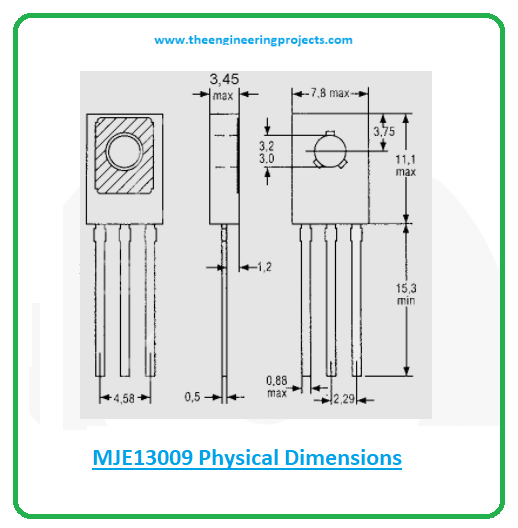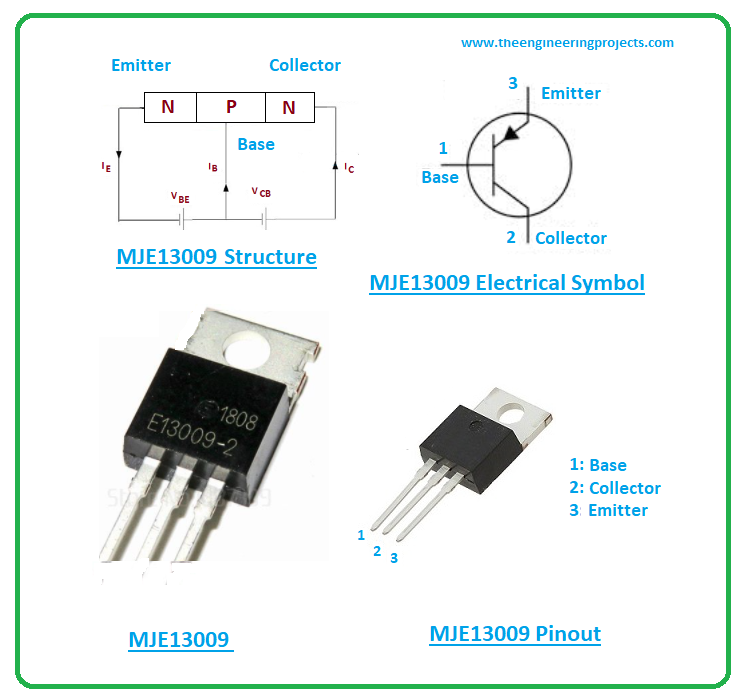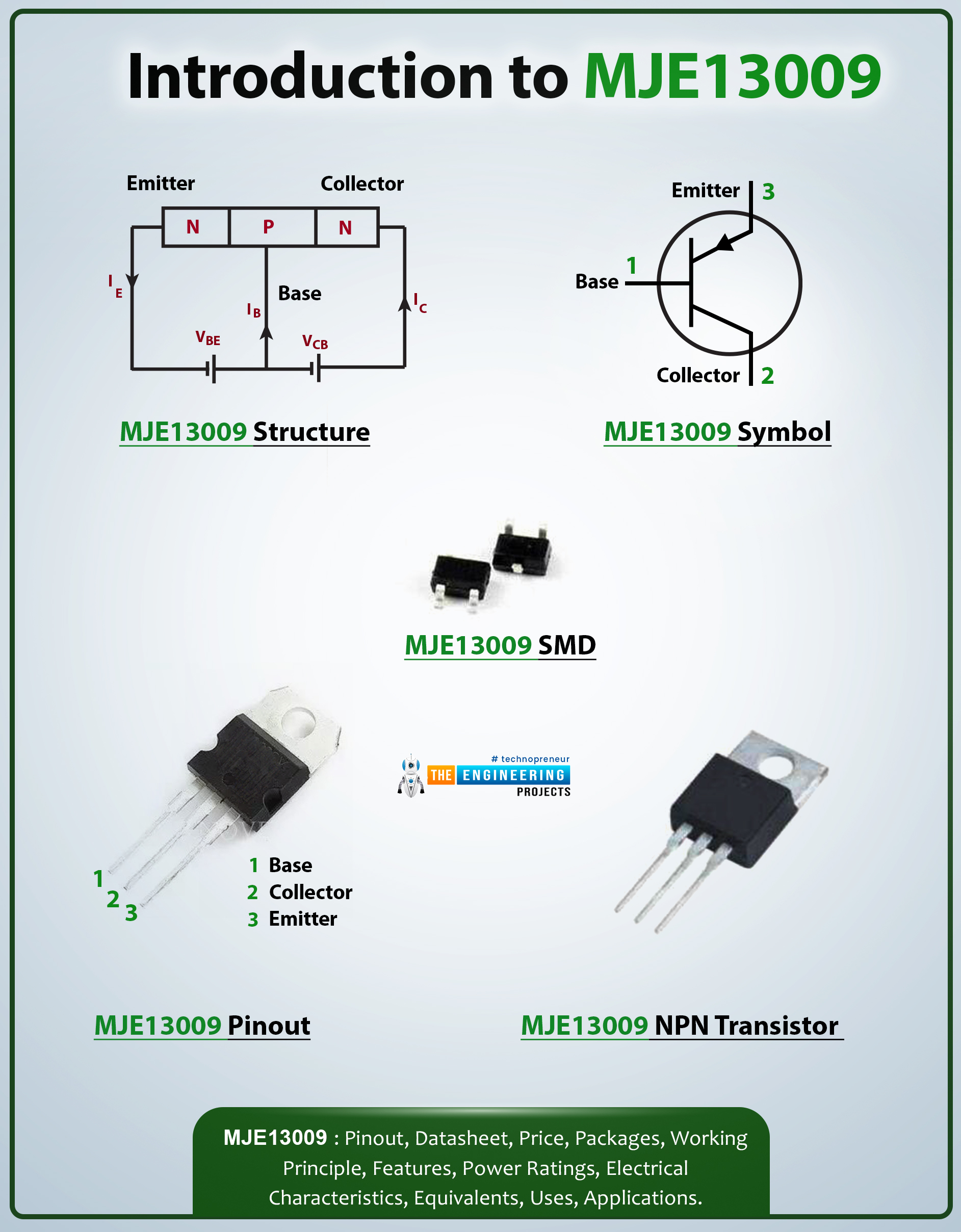
Hi Guys! I welcome you on board. Thank you for clicking this read. In this post today, I’ll walk you through the Introduction to MJE13009. MJE13009 is a semiconductor device made of silicon material that falls under the category of NPN transistors. This device is mainly used for switching and amplification purposes. The power dissipation of this device is 100W and the emitter-base voltage is 9V which is the amount of voltage needed to bias the device. I suggest you read this post all the way through as I’ll describe the complete Introduction to MJE13009 covering datasheet, pinout, features, and applications. Let’s get started.
Introduction to MJE13009
- MJE13009 is an NPN transistor mainly used for amplification and switching purposes.
- This is a semiconductor device made of silicon material and comes in a TO-220 package.
- MJE13009 is a three-layer device where two n-doped layers surround the one p-doped layer.
- This integrated chip contains three terminals named emitter, base, and collector.
- The small input current at the base pin is used to control the large output current at the remaining two terminals.
- MJE13009 is a type of bipolar junction transistor that belongs to the NPN transistor family where electrons are the major charge carriers.
- In a bipolar junction transistor, both electrons and holes play a key role in the conductivity inside the transistor. However, in the case of NPN transistors, electrons are major charge carriers while in the case of PNP transistor conductivity is carried out by the holes as major charge carriers.
- In NPN transistors current flows from the collector to emitter terminal while in the case of PNP transistor current flows from emitter to collector terminal.

- The NPN devices are preferred over PNP devices for a range of switching applications because the mobility of electrons is better than the mobility of holes.
- The bipolar junction transistors are current-controlled devices in contrast to MOSFETs that are voltage controlled devices and contain terminals drain, source, and gate. The gate terminal plays the same role in MOSFET what the base terminal plays a role in bipolar junction transistors.
- The collector-emitter voltage of this device is 400V and the collector-base voltage is 700V while the emitter-base voltage is 9V which is the amount of voltage that can bias the device and start transistor action.
- MJE13009 is mainly developed for high-power high-speed switching applications. And the collector current of this device is 12A which means it can support load up to 12A.
MJE13009 Datasheet
Before you incorporate this device into your electrical project, it’s wise to go through the datasheet of the component that features the main characteristics of the device. Click the link below to download the datasheet of MJE13009.MJE13009 Pinout
The MJE13009 carries three terminals known as:- Base
- Collector
- Emitter
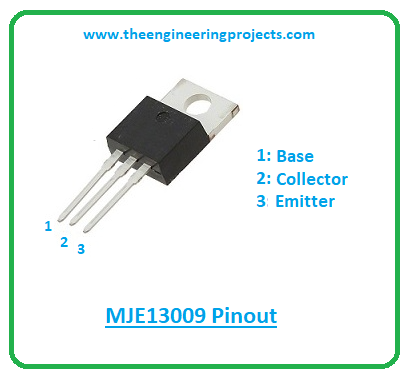
MJE13009 Working Principle
- The base pin is responsible for the overall transistor action. When voltage is applied at the base pin, it helps in biasing the device and current will start flowing from collector to emitter terminal.
- The different doping concentration of all these terminals is responsible for the lack of symmetry inside transistor device.
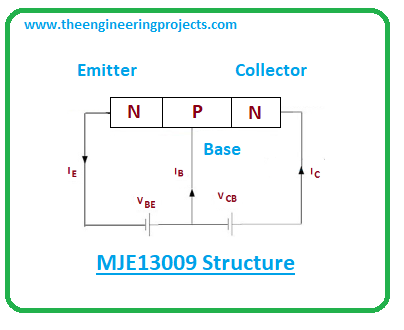
- Yes, bipolar junction transistors are not symmetrical which means if you interchange both collector and emitter terminals, it will force the terminals to stop acting in forward active mode and as a result, both terminals will start operating in reverse action mode.
- This exchanging of terminals can influence the value of both common-emitter current gain and common-base current gain.
MJE13009 Power Ratings
The following table shows the absolute maximum ratings of MJE13009.| Absolute Maximum Ratings of MJE13009 | ||||
|---|---|---|---|---|
| Pin No. | Pin Description | Pin Name | ||
| 1 | Collector-emitter voltage | 400V | ||
| 2 | Collector-base voltage | 700V | ||
| 3 | Base-emitter voltage | 9V | ||
| 4 | Collector current | 12A | ||
| 5 | Power dissipation | 100W | ||
| 6 | Base current | 6A | ||
| 7 | Operating and storage junction temperature range | -55 to 150C | ||
- The junction temperature and storage temperature ranges from -55 to 150C.
- The collector-emitter and collector-base voltages are 400V and 700V respectively. And total power dissipation is 100W which is the amount of power released during the working of this device. When you’re working with this integrated circuit, make sure the ratings don’t exceed the absolute maximum ratings. Otherwise, you’ll be risking your entire project.
- Moreover, don’t apply these ratings more than the required time, else they can affect device reliability.
MJE13009 Applications
MJE13009 is used in the following applications.- Used to support loads under 12A.
- Installed in the motor control circuit.
- Employed in Bistable and Astable multivibrators circuit.
- Employed for switching and amplification purpose.
- Used in voltage regulator circuits.
- Employed in the switched-mode power supply.
- Used in H-bridge circuits.
- Used in modern electronic circuits.
MJE13009 Physical dimensions
The following figure represents the physical dimensions of the IC MJE13009.